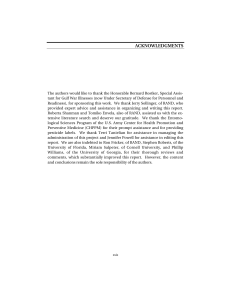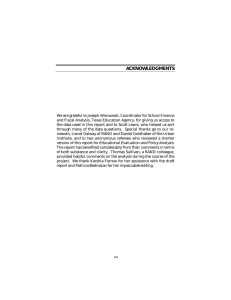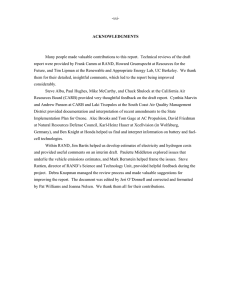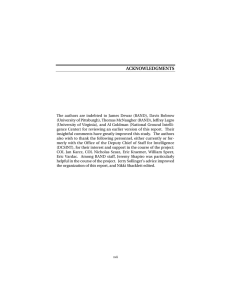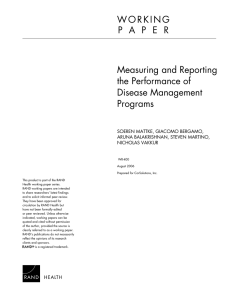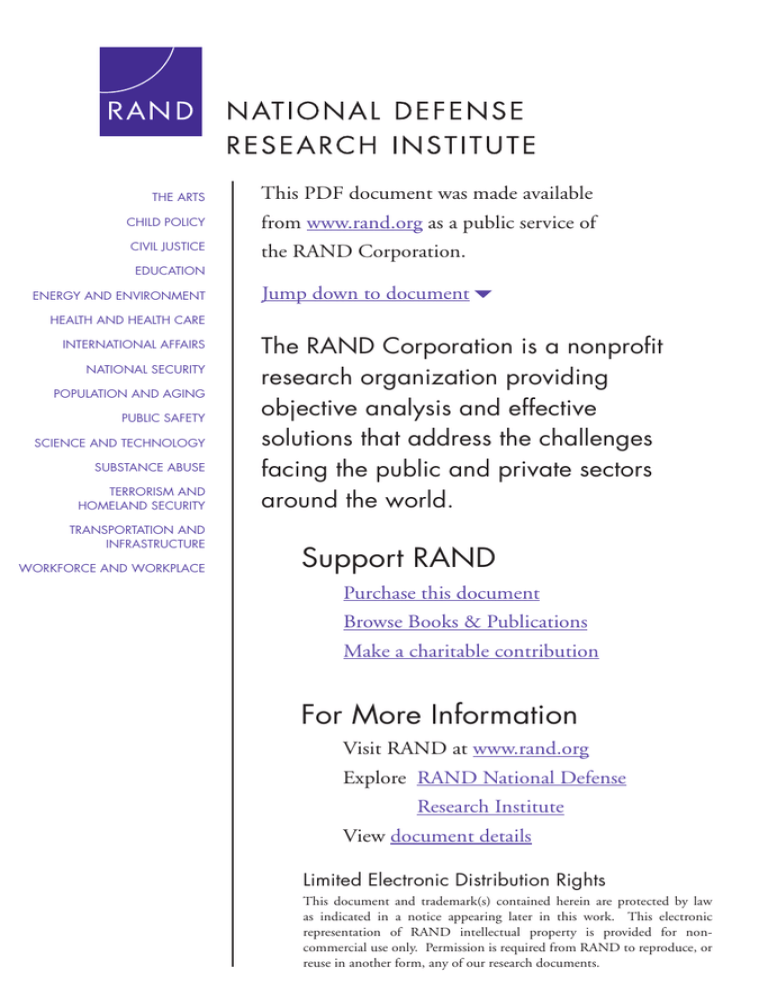
THE ARTS
This PDF document was made available
CHILD POLICY
from www.rand.org as a public service of
CIVIL JUSTICE
the RAND Corporation.
EDUCATION
ENERGY AND ENVIRONMENT
Jump down to document6
HEALTH AND HEALTH CARE
INTERNATIONAL AFFAIRS
NATIONAL SECURITY
POPULATION AND AGING
PUBLIC SAFETY
SCIENCE AND TECHNOLOGY
SUBSTANCE ABUSE
TERRORISM AND
HOMELAND SECURITY
TRANSPORTATION AND
INFRASTRUCTURE
WORKFORCE AND WORKPLACE
The RAND Corporation is a nonprofit
research organization providing
objective analysis and effective
solutions that address the challenges
facing the public and private sectors
around the world.
Support RAND
Purchase this document
Browse Books & Publications
Make a charitable contribution
For More Information
Visit RAND at www.rand.org
Explore RAND National Defense
Research Institute
View document details
Limited Electronic Distribution Rights
This document and trademark(s) contained herein are protected by law
as indicated in a notice appearing later in this work. This electronic
representation of RAND intellectual property is provided for noncommercial use only. Permission is required from RAND to reproduce, or
reuse in another form, any of our research documents.
This product is part of the RAND Corporation monograph series.
RAND monographs present major research findings that address the
challenges facing the public and private sectors. All RAND monographs undergo rigorous peer review to ensure high standards for
research quality and objectivity.
Russia’s Economy
Signs of Progress and Retreat
on the Transitional Road
Charles Wolf, Jr., Thomas Lang
Prepared for the Office of the Secretary of Defense
Approved for public release; distribution unlimited
The research described in this report was prepared for the Office of the
Secretary of Defense (OSD). The research was conducted in the RAND
National Defense Research Institute, a federally funded research and
development center sponsored by the OSD, the Joint Staff, the Unified
Combatant Commands, the Department of the Navy, the Marine Corps,
the defense agencies, and the defense Intelligence Community under
Contract W74V8H-06-C-0002.
Library of Congress Cataloging-in-Publication Data
Wolf, Charles, 1924–
Russia’s economy : signs of progress and retreat on the transitional road /
Charles Wolf, Thomas Lang.
p. cm.
Includes bibliographical references.
ISBN-13: 978-0-8330-3976-7 (pbk. : alk. paper)
1. Russia (Federation)—Economic conditions—1991– 2. Russia (Federation)—
Economic policy—1991– I. Lang, Thomas, 1975– II. Title.
HC340.12.W66 2006
330.947—dc22
2006030353
The RAND Corporation is a nonprofit research organization providing
objective analysis and effective solutions that address the challenges
facing the public and private sectors around the world. RAND’s
publications do not necessarily reflect the opinions of its research clients
and sponsors.
R® is a registered trademark.
© Copyright 2006 RAND Corporation
All rights reserved. No part of this book may be reproduced in any
form by any electronic or mechanical means (including photocopying,
recording, or information storage and retrieval) without permission in
writing from RAND.
Published 2006 by the RAND Corporation
1776 Main Street, P.O. Box 2138, Santa Monica, CA 90407-2138
1200 South Hayes Street, Arlington, VA 22202-5050
4570 Fifth Avenue, Suite 600, Pittsburgh, PA 15213-2665
RAND URL: http://www.rand.org/
To order RAND documents or to obtain additional information, contact
Distribution Services: Telephone: (310) 451-7002;
Fax: (310) 451-6915; Email: order@rand.org
Summary
Of the numerous economies considered to be “transitional,” Russia—
with a gross domestic product (GDP) about one-fifth that of China,
but a per capita product twice that of China—has the second largest.
Exactly where the Russian economy lies in the market-oriented gamut
of transitioning economies, however, is not yet clear: between, say,
Cuba, Belarus, Uzbekistan, and Vietnam at one end, and some of the
Balkan and central European states and China at the other end? Also
unclear, and probably more important, is the pace of the Russian economy’s transition and whether it is headed forward, toward market-oriented, decentralized resource allocation; backward, toward centralized,
state-controlled allocation; or is, instead, oscillating between these two.
These issues are controversial and vigorously debated within Russia.
Despite some statistical shadows and ambiguities, it is evident
that Russia’s aggregate economic growth since 1998 has been relatively
strong. In 2004, President Putin announced a goal of doubling the
Russian GDP over the next 10 years, implying an annual growth rate
of more than 7 percent, which is only slightly above the average rate
realized by the Russian economy since 1998. Since that date, Russia’s
annual GDP growth rate of over 6 percent has been about three times
that of the (unweighted) average of the other G8 members: Japan,
Germany, France, Canada, Italy, the United Kingdom, and the United
States.
Within this context, our study focused on four questions whose
answers shed light on some of the ambiguities surrounding Russia’s
status as a transitional economy:
xi
xii
Russia’s Economy: Signs of Progress and Retreat on the Transitional Road
1. How much of Russia’s relatively strong, yet varying, economic
growth is attributable to oil and natural gas prices, production,
and exports?
2. To what extent have other institutional and structural changes—
such as the growth of private enterprise and marketization—
affected Russia’s economic growth and its prospects?
3. What have been the scope and composition of Russia’s economic
transactions with several of its trading partners, specifically the
Central Asian states (Kazakhstan, Uzbekistan, Turkmenistan,
Tajikistan, and Kyrgyzstan), the “proliferation-risk” countries
(Iran and North Korea), and China?
4. How has the economy’s transition affected Russia’s defense
spending, defense industry, and arms exports?
To address the first question, we reviewed extensive data on oil
and natural gas prices, production, and export revenues, and the links
among them. We conclude that between one-third and two-fifths of the
variance in Russian economic growth in the past decade is explained
by changes in oil and natural gas prices and their concomitant effects
on aggregate production and export revenues.
In addressing the second question, on other institutional and
structural changes associated with the Russian economy’s transitional
progress, we focused on the impressive increase since 1996 in the
number of privately owned enterprises and the volume of employment
in the private sector, comparing these numbers with those for the stateowned and the mixed public-private sectors.
We also looked at the enhancement of Russia’s sovereign debt
status from “junk” status to investment grade by the major securities’
rating agencies as a complementary indicator of transitional progress.
For the third question, we reviewed the debate on Russia’s
expanded economic relations with the Central Asian states and with
China. It is our opinion that expanded economic relations in these
cases are more appropriately and objectively viewed as a reflection of
the Russian economy’s relatively high rate of economic growth, rather
than as a significant instrument of economic penetration and expanded
Russian economic influence in these countries. Russia’s exercise of eco-
Summary
xiii
nomic “leverage” through its energy exports is a legitimate U.S. concern, but one that is likely to be limited—at least in the medium and
longer term—by the fact that these transactions are increasingly occurring at market rather than subsidized prices. As for the two proliferation-risk countries, Iran and North Korea, Russia’s expanded economic
relations with them inevitably add resources to their ongoing and prospective weapons of mass destruction programs, a spillover effect that
should be of serious concern to the United States.
Finally, with respect to the fourth question, we conclude that
Russia’s defense sectors—military spending, the defense industry, and
arms exports—have thus far not prospered in the course of Russia’s
recent and continuing economic transition. These sectors experienced
acute resource deprivation in the immediate post-Soviet period. Based
on a brief review of the relevant data, it appears that the trough of
this deprivation has passed and that these sectors are likely to experience larger and continuing benefits from the sustained growth of the
Russian economy.

